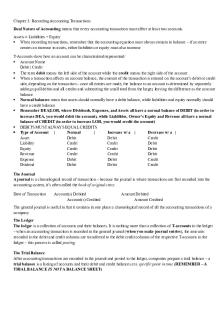Shannon London Review Sheet 3 PDF

| Title | Shannon London Review Sheet 3 |
|---|---|
| Author | Shannon London |
| Course | Human Anatomy & Physiology II |
| Institution | Southern University and A&M College |
| Pages | 2 |
| File Size | 51.1 KB |
| File Type | |
| Total Downloads | 89 |
| Total Views | 131 |
Summary
Review Questions for test...
Description
Review Sheet #3 Answers
1. 2. 3.
4. 5. 6. 7. 8. 9. 10. 11. 12. 13. 14. 15. 16. 17.
Which vitamin requires intrinsic factor in order to be absorbed? B12 How are most nutrients absorbed via the mucosa of the intestinal villa? Active transport drive directly or indirectly by metabolic energy Define the following terms: anabolism, fermentation, mastication, and catabolism. Anabolism: provides the material needed for cellular growth and repair…larger molecules are made from smaller ones…requires energy Fermentation: the anaerobic enzymatic conversion of organic compounds, especially carbohydrates, to simpler compounds Mastication: the process of chewing food in preparation for deglutition and digestion; the act of grinding or comminuting with the teeth Catabolism: the enzyme-regulated chemical reactions that release energy…the breakdown of complex organic compounds into simpler ones…large is broken down to small What does chief and parietal cells secrete? Review electrolyte absorption. Review nervous control of gastric secretion. What are functions of the stomach? Liver damage would mostly affect the digestion of ________________. Lipids. Review gastric phase of gastric secretion. Review the following hormones and their function (s): cholecystokinin, secretin, gastric inhibitor peptide, and gastrin. What is the function of goblet cells? Review the tunica of the digestive tract especially the small intestines. Type of papillae on the tongue that contains taste buds. Review the function of hepatocytes. What produces intrinsic factor? Parietal cells. What hormones or paracrines that inhibit gastric secretion? What is the importance of tubular secretion? Tubular secretion is important for all EXCEPT which of the following? -Ridding the body of excess glucose
18. 19. 20. 21. 22. 23. 24. 25. 26. 27. 28. 29. 30. 31. 32.
Describe kidney function in older adults. What are methods by which the cells of the renal tubules can raise blood pH? What are factors that favor filtrate formation at the glomerulus? What is the composition of glomerular filtrate? How is the initiation of micturition triggered? Know the structure of the renal corpuscle. Know the sequence from the formation to elimination of urine. What are the chemoreceptors in the kidney that respond to changes in solute content? What is the function of the juxtaglomerular apparatus? Know functions of the nephron loop. What triggers the release of renin? What is prostate cancer? What is the hypothalamic-pituitary-gonadal axis? Know the tooth that bears the force of chewing. What is the essential role played by the large intestinal bacteria?
33. 34. 35. 36. 37. 38. 39. 40. 41. 42.
Know the functions of bile. How the surface area of the small intestines increased? Know the functions and composition of saliva. What are the hormones responsible the direct water reabsorption? Know the function of ADH. What is the chief force pushing water and solutes during filtration? What is the makeup of the filtration membrane? Know functions of the urinary system. Know the angiotensin renin aldosterone system. Know the importance of each stomach secretion....
Similar Free PDFs

Shannon London Review Sheet 3
- 2 Pages

POLS207 Review Sheet 3
- 3 Pages

Exam Review sheet 3
- 8 Pages

PSY365 Quiz 3 Review Sheet
- 10 Pages

Review sheet
- 42 Pages

Indice di Shannon
- 3 Pages

Betty Shannon - dfdfd
- 2 Pages

TEORI INFORMASI SHANNON
- 1 Pages

Astro Final Review Sheet
- 28 Pages

Practical 2 Review Sheet
- 5 Pages
Popular Institutions
- Tinajero National High School - Annex
- Politeknik Caltex Riau
- Yokohama City University
- SGT University
- University of Al-Qadisiyah
- Divine Word College of Vigan
- Techniek College Rotterdam
- Universidade de Santiago
- Universiti Teknologi MARA Cawangan Johor Kampus Pasir Gudang
- Poltekkes Kemenkes Yogyakarta
- Baguio City National High School
- Colegio san marcos
- preparatoria uno
- Centro de Bachillerato Tecnológico Industrial y de Servicios No. 107
- Dalian Maritime University
- Quang Trung Secondary School
- Colegio Tecnológico en Informática
- Corporación Regional de Educación Superior
- Grupo CEDVA
- Dar Al Uloom University
- Centro de Estudios Preuniversitarios de la Universidad Nacional de Ingeniería
- 上智大学
- Aakash International School, Nuna Majara
- San Felipe Neri Catholic School
- Kang Chiao International School - New Taipei City
- Misamis Occidental National High School
- Institución Educativa Escuela Normal Juan Ladrilleros
- Kolehiyo ng Pantukan
- Batanes State College
- Instituto Continental
- Sekolah Menengah Kejuruan Kesehatan Kaltara (Tarakan)
- Colegio de La Inmaculada Concepcion - Cebu





